Attracting hummingbirds to your garden is a fun way to connect with nature, enjoy wildlife nearby, and help do your part to ensure a healthy ecosystem. Hummingbirds can eat nectar from flowers and plants, which you can choose to attract these birds to your garden. But if you don’t have a green thumb, you can still invite these fascinating animals to your yard. An easier way to make your yard attractive for hummingbirds is to use a feeder.
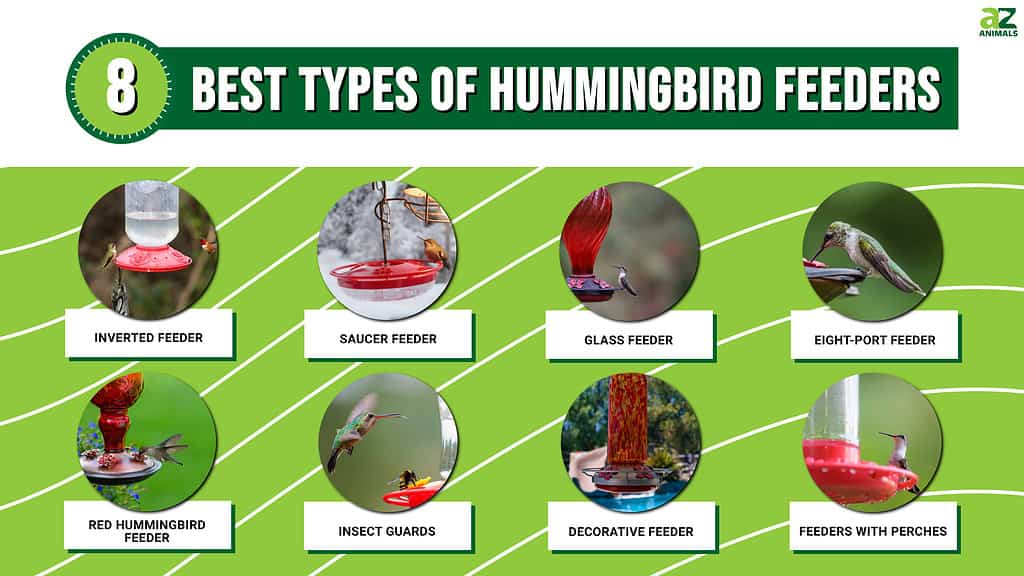
With most feeders, you fill a reservoir with special nectar that hummingbirds like. It is similar to what they would get from flowers. There are a variety of styles that range from simple and functional to elaborate and decorative. The basic design allows the birds to access the nectar. But beyond that, you can find plenty of options to suit your style and needs.
#1 Inverted Feeder
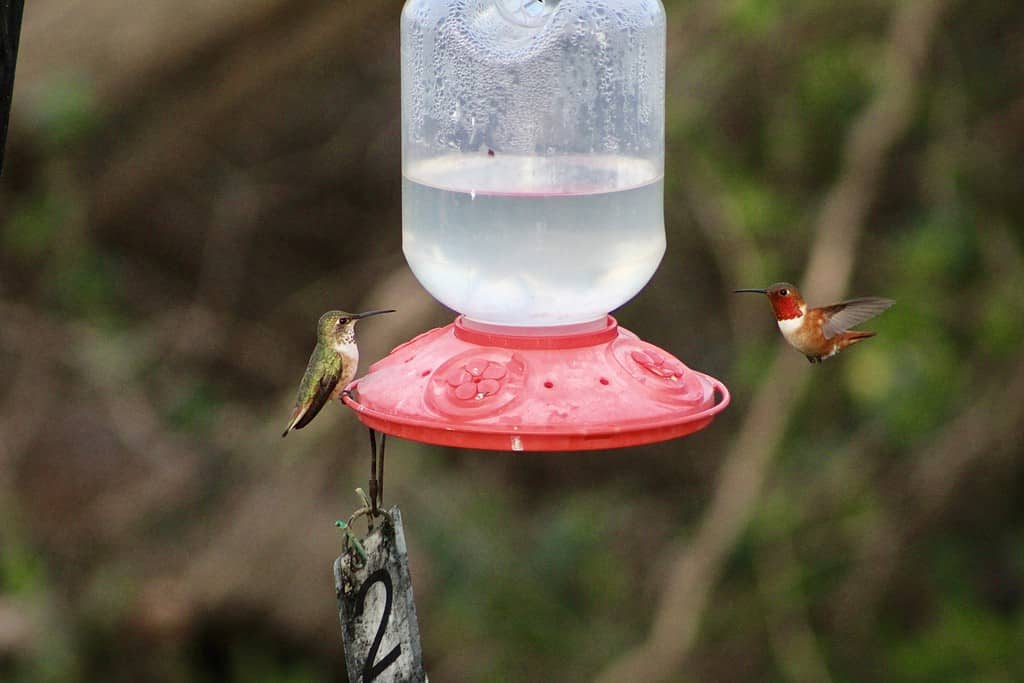
Inverted feeders keep the nectar in a reservoir above the base.
©Joseph Tointon/iStock via Getty Images
This is the most common hummingbird feeder design. In these feeders, nectar is stored in an inverted reservoir that is connected to a base that allows the hummingbirds to get to the nectar. The nectar comes out of small ports at the base. Hummingbirds dip their long tongues into the ports to get to the nectar. This replicates the way that hummingbirds get to their food when they eat from the central portion of flowers.
These feeders can be large or small but typically store more nectar than other options. They look great and stay in place with minimal spills. It can be a little bit tricky to fill them since you’ll have to remove the inverted reservoir without spilling what is inside. It’s best to let the birds completely exhaust the nectar so that the reservoir is empty when you need to take it off and refill it. After filling the reservoir, be careful when you attach it to the base. Do it slowly to keep any extra from leaking or spilling.
#2 Saucer Feeder

Saucer feeders store nectar under the feeding area and birds access it via feeding ports.
©sophiecat/Shutterstock.com
These popular hummingbird feeders also provide access to nectar via small ports. But instead of a large reservoir on the top, the extra nectar is stored in a saucer under the ports. The birds dip their beaks and long tongues into the nectar. They rarely spill and can be mounted on top of railings for fun viewing opportunities. They are also much easier to fill since all you have to do is add nectar to the saucer.
The downside of saucer styles is that they tend to be smaller. The birds might not be able to access all of the nectar, depending on how deep the saucer is. Birds that are unfamiliar or new to your yard might not immediately recognize them as feeders since they look less like flowers.
#3 Glass Feeder

Glass hummingbird feeders come in a variety of sizes and shapes.
©Randall Vermillion/Shutterstock.com
Why are there so many hummingbird feeders with glass reservoirs or saucers? The main reason is that it is very easy to keep track of the level of nectar in clear or slightly opaque glass. This is one of the most popular materials for hummingbird feeders, although sometimes the base of the feeder is made of metal or plastic. The ports can also be made of plastic, which can be easier to clean when needed.
Glass hummingbird feeders tend to be heavier, especially when they are full of nectar. Make sure that your hanging hook can handle the weight of the feeder when it is full. If you aren’t sure, it’s better to get a larger or heavier-duty hook, rather than risk breaking the feeder. The glass tends to be thick and durable, but it’s still important to be careful since broken glass can be dangerous and difficult to clean up.
#4 Eight-Port Feeder
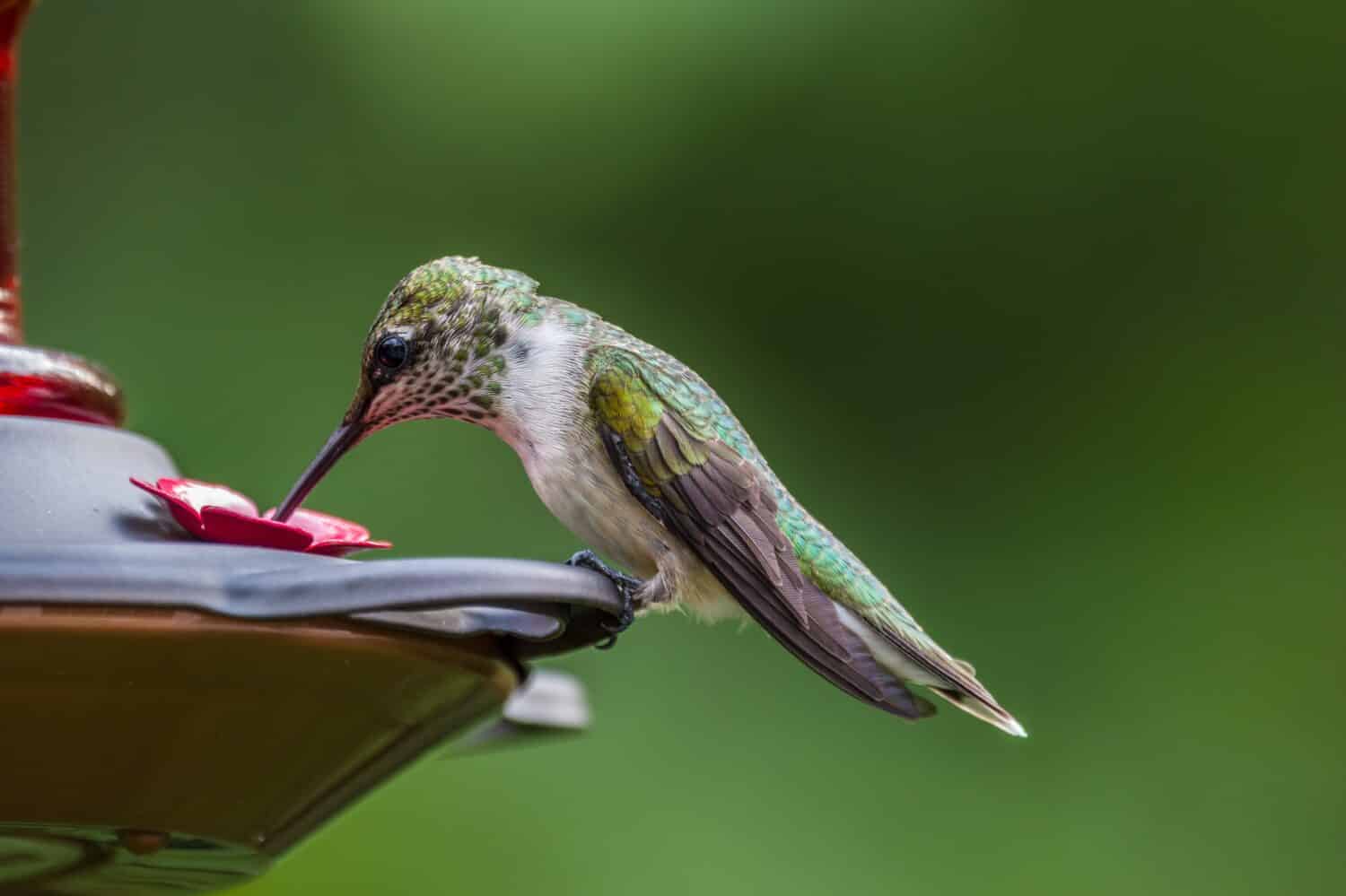
Hummingbirds access the nectar inside feeders using a feeding port.
©Sandra Burm/Shutterstock.com
Most hummingbird feeders have between 1 and 6 ports for feeding. This allows multiple birds to feed at the same time, although it’s unusual for all of the ports to be occupied at the same time. Larger feeders can have up to 8 ports. This can reduce competition between birds to get to the nectar. In some cases, hummingbirds may be territorial and stay nearby to prevent other hummingbirds from getting access to what they consider “their food.” Larger feeders with more ports can reduce this and result in more visitors to your feeder.
#5 Red Hummingbird Feeder
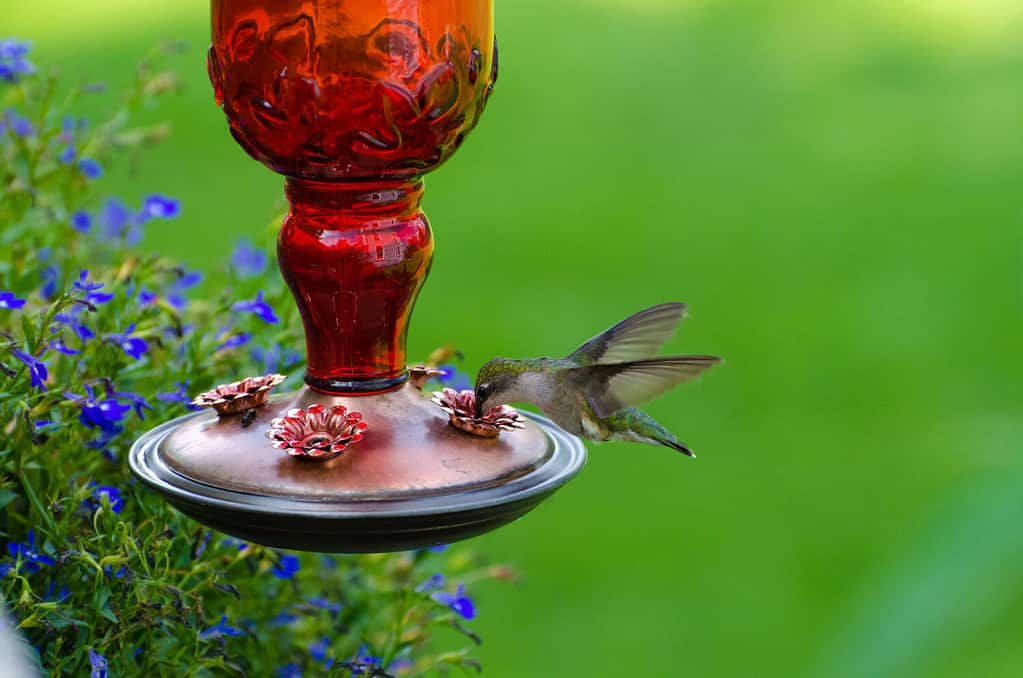
Hummingbird feeders often have red reservoirs, bases, or accents to attract birds to them.
©redtbird02/Shutterstock.com
These come in inverted and saucer styles but get special mention on our list because the color red is especially attractive to hummingbirds. Red is by far the most common color for hummingbird feeders. Everything from the reservoir or saucer to the base and especially the ports can be red. The nectar inside may also be red-colored, adding the color even if your feeder has clear glass or plastic. This can attract more hummingbirds to your feeder and garden. It isn’t absolutely necessary but is so effective that it dominates the hummingbird feeder market.
#6 Insect Guards

Bees also like to drink nectar from hummingbird feeders when they find them.
©Danita Delimont/Shutterstock.com
These can be built into a feeder or added as an additional accessory. Unlike other bird feeders which can attract squirrels and chipmunks, hummingbird feeders are attractive for insects and bees. Once ants find the feeder, often by climbing up the support pole or hook, a steady line can develop. These will deter hummingbirds from coming to the feeder and eat up the nectar. Bees are also attracted to the nectar in these feeders. They eat the same type of nectar.
If you’d rather keep your feeder for the birds, adding an insect guard will make it harder for these small insects and bees to get to the nectar. You can find them as add-on pieces or integrated into the feeder design. If you opt for a built-in one, it will limit the available choices and make it a bit heavier. Make sure to get the appropriately sized hook or support pole.
#7 Decorative Feeder
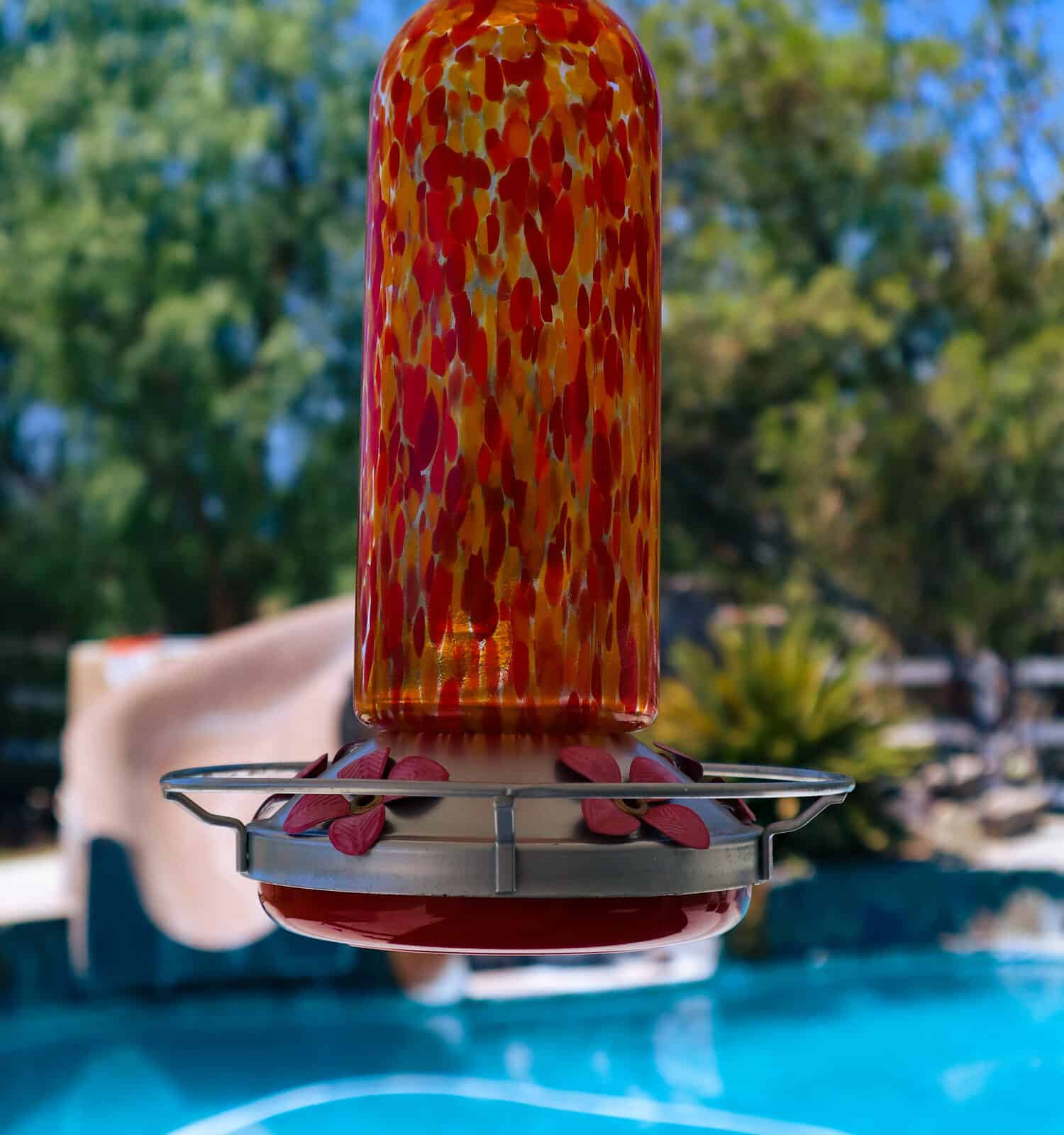
Decorative hummingbird feeders look great and attract hummingbirds.
©Alejandro Rossi/Shutterstock.com
If you want to take the style up a notch, look for a feeder that has swirled glass, extra colors and designs, or flower accents. You can find just about any style if you search. Swirled glass tends to be the most popular decorative element. Faux flowers are also common, especially on the base or by the feeding ports. These look nice for people watching the feeder and birds looking for some nectar to eat.
#8 Feeders with Perches
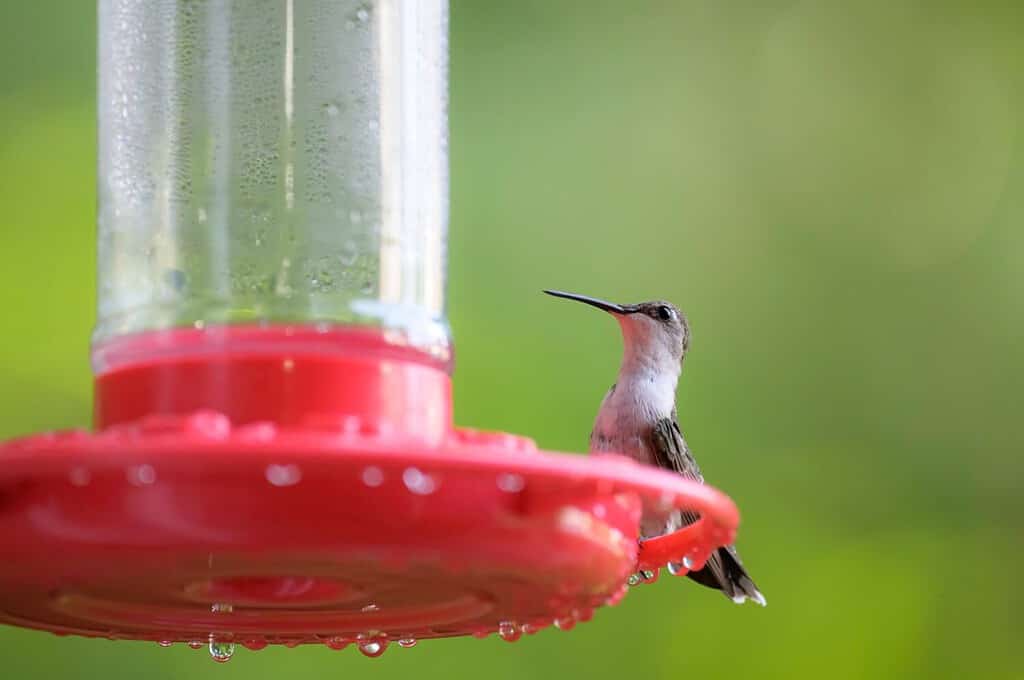
Many feeders have rails for birds to perch built into the base.
©LHolmes Photography/Shutterstock.com
Hummingbirds don’t require perches to eat. In fact, they move their wings to stay in place in the air while feeding. But having a perch can let the birds get some rest and wait their turn for a space at the feeder. Some have built-in perches on the base. Because hummingbirds are very small, it doesn’t take a lot of extra space or material to add a ring around the outside where the birds can perch. Some feeders have larger perches, although these can invite larger birds to come perch as well. While they may not go for the nectar, large birds may keep the smaller hummingbirds from coming to the feeder.
| Type of Feeder | |
|---|---|
| 1 | Inverted Feeder |
| 2 | Saucer Feeder |
| 3 | Glass Feeder |
| 4 | Eight-Port Feeder |
| 5 | Red Hummingbird Feeder |
| 6 | Insect Guards |
| 7 | Decorative Feeder |
| 8 | Feeders with Perches |
The photo featured at the top of this post is © Christine Balleau/iStock via Getty Images
Thank you for reading! Have some feedback for us? Contact the AZ Animals editorial team.







